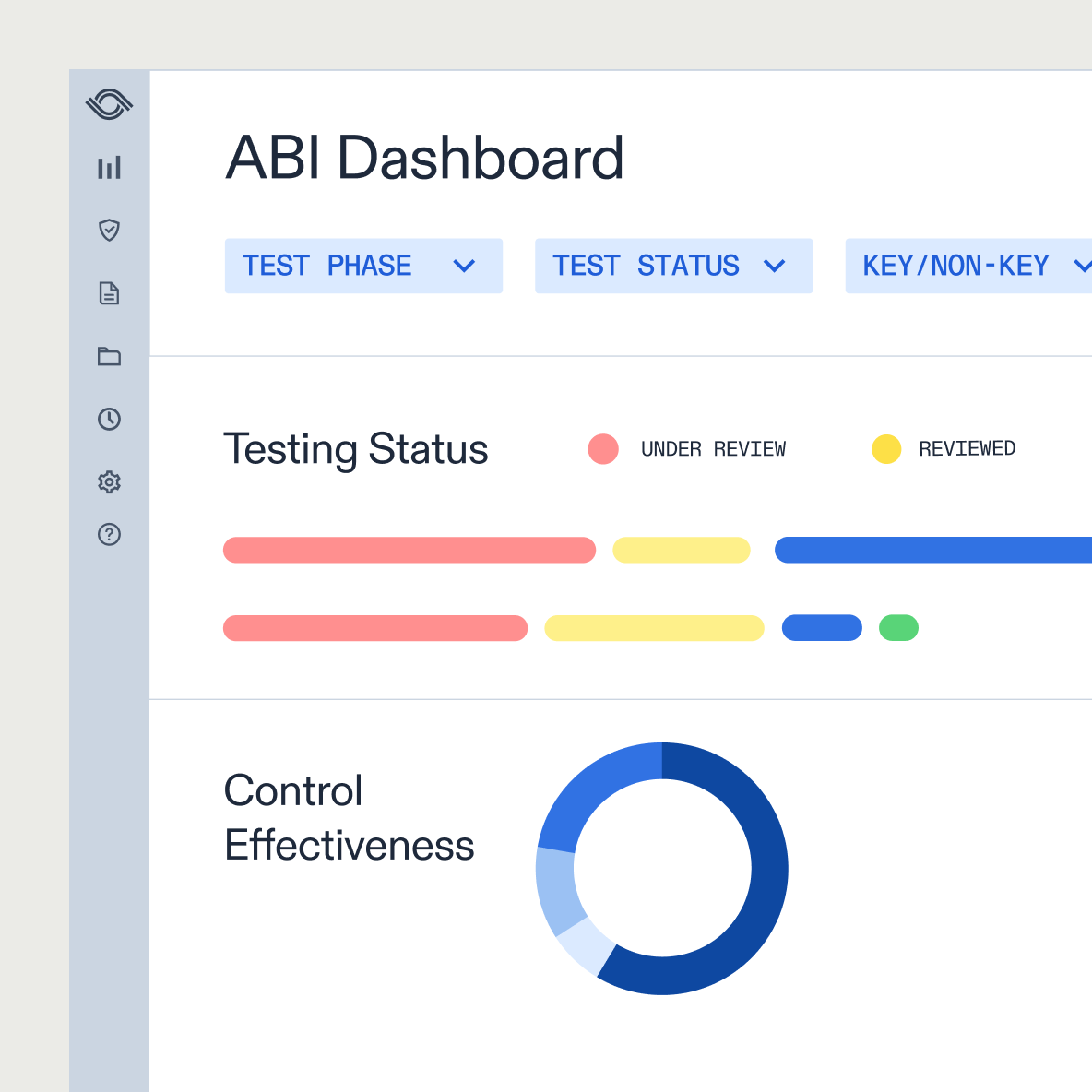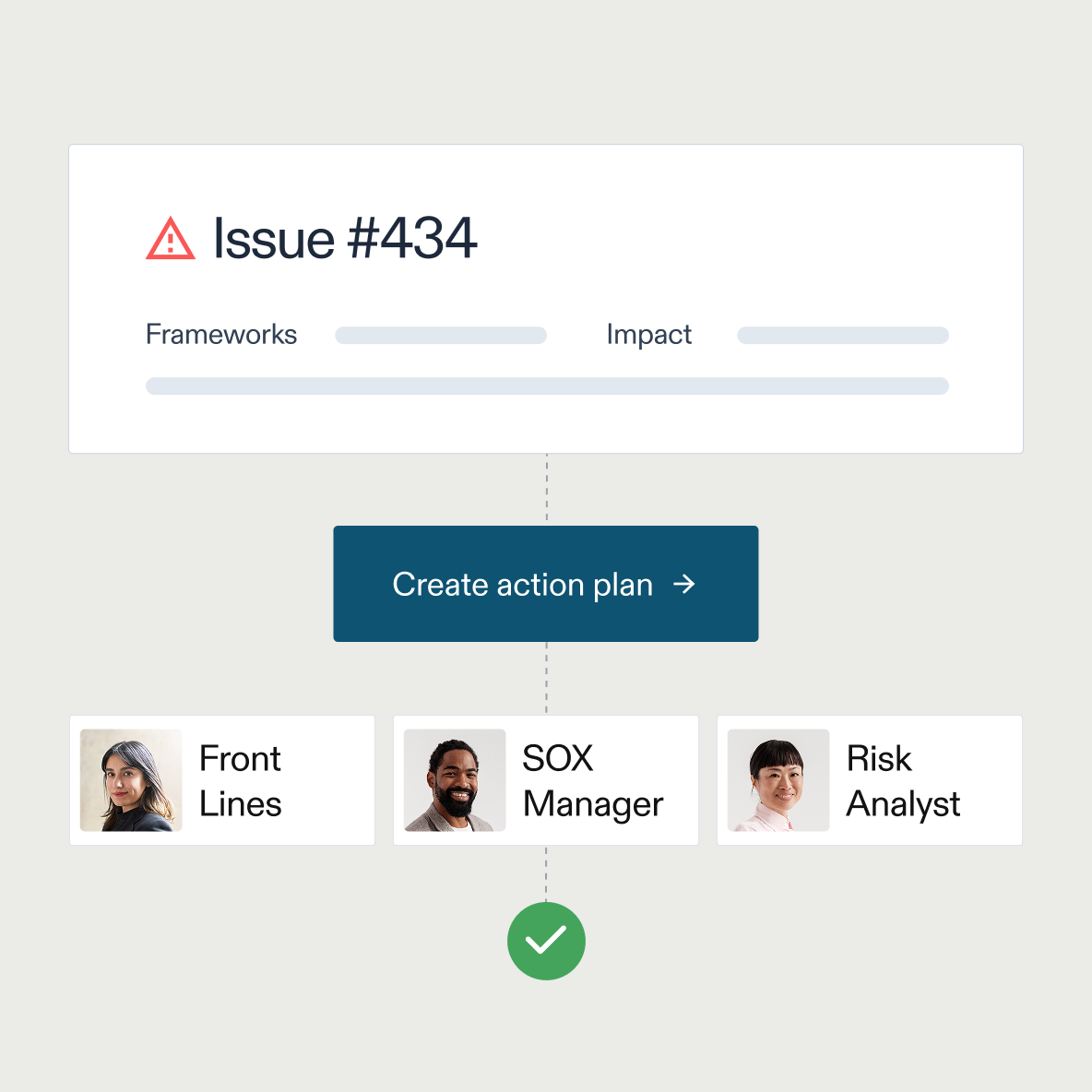
June 18, 2025 • 16 min read
Cybersecurity GRC for proactive risk and real-time visibility

Ender Baykal
Cybersecurity risk and compliance still live in separate lanes at most enterprises — one team buried in spreadsheets and evidence requests, the other chasing emerging threats as if they're all equally urgent. If you're lucky, everyone meets up once a quarter. If you're not, critical risks slip through the cracks while audit prep soaks up months that could have gone to real risk reduction.
It's a problem you can feel: fragmented tools, manual evidence collection, and a patchwork of processes that don't talk to each other. And the cost isn't just an operational headache. Your actual cyber risk may be growing right under your nose. The governance, risk, and compliance (GRC) status quo simply can't keep up.
The good news? There's a better way forward. New approaches to cybersecurity GRC make it possible to see risks clearly, connect the dots, and act before issues spiral out of control. Instead of drowning in disconnected data, your teams can finally manage risk proactively and get real-time visibility into what matters most.
What cybersecurity GRC is (and why it's changing)
Cybersecurity GRC pulls together your governance, risk management, and compliance work into one connected system. You set clear rules for how your company protects data, track what could go wrong, and keep proof that your security controls work.
The old GRC approach relied on scattered policies, slow risk reviews, and evidence spread across inboxes. Now, threats move faster — and so does the technology. AI is changing how GRC gets done: Teams can spot issues, pull evidence, and act on risks in minutes instead of weeks.
Modern cybersecurity GRC isn’t about ticking boxes. It’s about having one playbook that handles threats, keeps you compliant, and gives you confidence your security actually works.
The convergence of infosec and governance
Historically, infosec and governance ran on different tracks. Security teams chased threats while governance handled policies, frameworks, and board updates. Now, the boundaries are blurring fast.
Now, more companies are putting their security and governance teams in the same room. They review risks together and track progress in the same tools. Instead of waiting for handoffs, they talk regularly and use shared dashboards to see which threats and gaps matter right now. This collaboration gives both sides a real-time view of security gaps, compliance responsibilities, and business priorities — so decisions aren’t made in isolation.
Security controls, risk registers, and compliance evidence all live in the same ecosystem (or should), because threat actors and regulators don't care about your org chart. With the rise of AI, shared data, and integrated tooling, what used to be parallel efforts are starting to feed each other.
Infosec needs the strategic context and discipline of governance, while governance needs up-to-the-minute understanding of risk from infosec.
Why it's more than just IT compliance
For too long, cybersecurity GRC was treated like a rebranded IT compliance checklist. Prove you ticked the right boxes, upload some evidence, and hope for the best. That era is ending fast. Modern regulators, customers, and boards want to know how your organization will spot new risks, adapt to rapid change, and keep critical sensitive data safe on an ongoing basis.
AI accelerates this shift, automating routine tasks and surfacing risk patterns that static checklists miss entirely. GRC is about more than being audit-ready. Now, it's about active, intelligent risk management that protects the whole enterprise (not just the IT department).
So, what does this shift really mean for how infosec, compliance, and governance come together now? The answer starts with understanding why the worlds of risk and information security can't afford to stay siloed.
How cybersecurity GRC supports enterprise strategy
For most leaders, "risk" isn't just a technical debate or a compliance hurdle — it's part of all strategic decision-making. Want to launch a new digital service? Expand into a new market? Speed up M&A?
All that momentum runs straight through your security posture, and if you don't have a real-time grip on where threats are lurking, the brakes come on.
And the stakes keep rising. In a survey of C-suite executives, cybersecurity emerged as the most pressing long-term risk, with its risk rating increasing by over 11% over the previous year, the largest increase in the survey's history.
Modern cybersecurity GRC turns that bottleneck into a source of clarity. When your risk, security, and compliance data finally live in one place — and not buried across teams or hidden in month-old reports — you get a true view of how risk links to your biggest business objectives.
Instead of waiting for quarterly audits or reacting to surprises, leaders can spot patterns early, see how a single security gap cascades into compliance or operational issues, and make informed decisions with the full story in front of them.
AI and automation only raise the stakes and the opportunity here. Fast, cross-functional insight lets you quantify risk in dollars. It means knowing where your exposures are before a new product launch or vendor partnership. And that clarity helps you align with the company’s overall risk appetite and strategy.
Capabilities that define modern cybersecurity GRC
Not all GRC solutions are created equal. The tools you choose (and the gaps you accept) are the difference between a team that's simply audit-ready and a GRC program that protects your business. In the pressure cooker of real-world risk, a few core capabilities separate the leaders from everyone else.
Continuous monitoring and evidence automation
You can't defend what you can't see. Quarterly risk assessments, static spreadsheets, and frantic email trails simply don't cut it. Continuous monitoring flips the script, surfacing fresh risk signals as they happen, not after the damage is done.
Even more important? Automated evidence collection. Instead of chasing down screenshots and sign-offs, your team has proof ready at a click, freeing up time for real mitigation work.
Unified control mapping across frameworks
Most companies juggle multiple frameworks, like NIST, ISO, SOC 2, and HIPAA (and that's on a slow year). Mapping controls across these frameworks by hand is a recipe for duplicate work, missed gaps, and endless version confusion.
A unified approach lets you update once and see changes ripple everywhere they're relevant. No more piecing together compliance stories or redoing evidence for every new requirement. The best platforms make it one-and-done.
Risk-based prioritization and reporting
Not all risks weigh the same, but when your tools can't help you separate the critical from the cosmetic, you end up reacting to every issue with the same intensity, and the real threats get lost in the noise.
Risk-based prioritization — driven by real-time data and, now, AI-powered analysis — gives you a clear sense of where to focus.
Reporting stops being meaningless paperwork. It becomes a strategic tool that helps security and compliance teams tell the right story to the right stakeholders. With the right data, these teams can drive business goals instead of constantly playing defense.
Collaboration across security, compliance, and risk
Risk is everyone's business, but too often, teams operate in silos, lobbing tickets or forwarding spreadsheets instead of collaborating. Modern GRC platforms break down these walls, creating shared workspaces, role-based access, and workflows that make cross-team alignment the default, not an afterthought.
When infosec, compliance, and risk teams move in sync, you solve root problems instead of just patching symptoms, and everyone spends less time in meetings and more time making progress on business processes.
Where most cybersecurity GRC tools fall short
GRC software makes a lot of promises. Many tools struggle to deliver consistent value during high-pressure periods like audits or incidents. If you've spent more time wrestling with your software than managing risk, you're not alone. Here's where the cracks usually show.
Fragmented systems and manual evidence collection
Every team has its own tool or, worse, its own spreadsheet. Evidence is scattered across inboxes, cloud drives, and apps that weren't built to play nice together. When audit or incident time comes, everyone scrambles, and context is always missing.
The outcome? Delays, missed issues, and a lot of stressed-out teams.
The consequences are real. In CISA's 2023 vulnerability assessments, threat actors successfully used Valid Accounts (T1078) as their primary method of gaining initial system access, highlighting how credential management (a basic GRC control) remains a critical weak point for most organizations.
Lack of collaboration across infosec, compliance, and risk
Silos aren't just an annoyance. They're a risk in themselves. Security might spot an issue, but if compliance doesn't hear about it until review time, you're not managing risk — you're managing surprises. Without a shared workspace and common language, small miscommunications become repeat findings. Bridget Keller, VP of Internal Audit at Berkadia, says:
“CrossComply alerts the enterprise risk management team if there’s been perhaps a weak control that’s now ineffective. It allows all of these different teams to see this data in real time. As soon as my team or I indicate that this control is ineffective, the entire team will see it.”
Overreliance on reactive compliance
Most legacy platforms are built for one thing: checking boxes when someone asks for proof. But in a world where data breaches happen overnight, "look back" compliance isn't enough. If your system can't help you see and respond to new risks as they happen, you're not mitigating risks at all.
Missing automation and integration
Some GRC platforms put visuals and reporting front and center — another dashboard here, a few more charts there — while glossing over what helps risk teams scale.
Without deep functionality like automation and integration, even the flashiest tools just add to the frustration and confusion.
Best-in-class means less busywork, fewer mistakes, and a risk picture you can finally use to support regulatory compliance efforts.
How AuditBoard supports cybersecurity GRC
A decent risk tool keeps you from scrambling. A great one lets you see risk in context, act faster, and get the credit when your controls keep a crisis from erupting. AuditBoard's platform gives infosec, risk, and compliance management teams the connected visibility they need, without burying the business in busywork.
Connected risk and control visibility in real time

No more waiting for a quarterly rollup to know where you stand. AuditBoard provides a centralized workspace where teams can view risk registers, control statuses, and remediation progress, with updates reflecting user activity or scheduled workflows.
This means senior management gets clarity. Frontline teams see exactly how their fixes impact broader business priorities versus their own to-do list.
Automated evidence collection and continuous monitoring
AuditBoard takes the mind-numbing stuff off your plate. Evidence collection? Automated. Routine control testing? Running in the background without your team having to nudge or beg. When auditors or regulators ask, you already have clean, mapped evidence. No scrambling through emails or random file shares.
Risk management strategies become simpler to implement when your team isn't buried in manual evidence collection. With AuditBoard, you can focus on what matters: finding and fixing vulnerabilities before they impact data security and operations.
Role-based collaboration across infosec, risk, and compliance
AuditBoard is built for teams, not silos. Everyone gets the right level of access and sees the data that matters for their role, project, or region. Updates don't get lost in translation or held up for a sign-off because they're tracked, visible, and actionable by the right people in real time.
The CISO gets the strategic view they need while teams on the ground maintain detailed control over implementation — all in one unified platform that bridges the gap between cybersecurity governance and daily operations.
A proactive platform for scalable cyber risk management

AuditBoard doesn't just scale up; it keeps you ahead. Plug in your existing tools, adapt dashboards when frameworks change, and automate more as risks get more complex. Instead of reacting, you're risk-aware and ready for what's next, whether you're managing a single environment or dozens worldwide.
Cybersecurity measures are only as good as the visibility you have into them. AuditBoard provides the transparency and tracking you need to prove your controls work, with real metrics that show progress.
Build a cyber risk program you’re genuinely proud of
You don’t have to settle for constant firefighting or “good enough” compliance. With the right GRC approach, risk and compliance become something your whole team can own, easing work, strengthening trust, and building real resilience together.
A connected platform means you get the clarity and confidence to focus on what matters, adapt to change, and celebrate real progress. Modern cybersecurity advances your data protection and data privacy initiatives, empowering people, not just processes, as you grow.
Give your team the tools and insight they deserve — proactive cybersecurity, streamlined workflows, and support for your biggest goals.
Ready to see what’s possible? Get a closer look at AuditBoard.
About the authors

Ender Baykal is a CISA- and CRISC-certified cybersecurity professional with over 7 years of experience in IT audit, risk, and compliance. Currently serving as Manager of Product Solutions at AuditBoard, he helps enterprise organizations operationalize risk and control frameworks at scale. With a foundation in Big 4 advisory, Ender specializes in aligning complex requirements with practical, technology-driven solutions that enhance governance, risk, and compliance maturity.
You may also like to read


Connected risk: The AI-driven convergence of audit, risk, and compliance

AI governance and the future of GRC

Beyond the compliance checklist: Risk-driven cyber GRC

Connected risk: The AI-driven convergence of audit, risk, and compliance

AI governance and the future of GRC
Discover why industry leaders choose AuditBoard
SCHEDULE A DEMO



